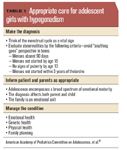The menstrual cycle in adolescents
Menstrual regularity in adolescent girls provides valuable clues about current and future bone integrity.

Key Points
Menstruation is a Jekyll-and-Hyde phenomenon, depending on cultural context.1 As Hamlet says: "There is nothing either good or bad, but thinking makes it so." Many anthropologic accounts stress the importance of menarche as a sign of a girl's transition into womanhood, physical maturity, and fertility, and something to be celebrated. Some American Indian cultures mark the first menses with an elaborate celebration, such as the Apache Sunrise Dance. Such rituals are a positive and enabling social force. For these American Indian tribes, the first menstrual cycle places the girl in an empowered state in which she can influence the well-being of others.2 In some cultures, however, including in the United States, menstruation is viewed as a nuisance and a source of physical and psychological problems. Research suggests that girls in the United States are not knowledgeable about menstruation and that their expectations regarding it are negatively biased.3

Bone health presents an opportunity to say something positive about menstruation and give the menstrual cycle due respect. In studying girls and young women with primary ovarian insufficiency, it has become clear that the menstrual cycle is a marker of general health.6 According to published data, more than 50% of women with primary ovarian insufficiency (also known as premature menopause or premature ovarian failure) saw 3 or more different clinicians before somebody took the condition seriously and performed laboratory testing to make a diagnosis.7 Also, many women delayed seeking evaluation, and most did not consider missing menstrual periods as a significant problem. The cost for a delay in diagnosis of an estrogen-deficient state is reduced bone mineral density.8
The goal of this article is 2-fold: 1) to advocate for a more aggressive approach to the evaluation of amenorrhea; and 2) to appeal for a comprehensive approach to the management of hypogonadism to optimize bone health and reduce the risk of osteoporosis in later years. To care appropriately for adolescents with hypogonadism, the clinician needs to make the diagnosis in a timely manner, inform the patient (and the parents/guardians, in the case of a minor) of the diagnosis with due care, determine the cause of the condition, and manage the potential emotional and physical sequelae (Table 1).10
The view that anything goes with regard to menstrual cycle regularity during adolescence is an unfortunate misconception that is a major contributor to the delay in diagnosis of hypogonadism in this population. Longitudinal studies of the menstrual cycle in normal girls have demonstrated unequivocally that, even during the first year after menarche, it is statistically unusual for a girl to have more than 90 days between menses.10-12 Therefore, evaluation is indicated for cycle intervals of more than 90 days.
A complete discussion of the evaluation and management of delayed puberty and primary amenorrhea is well beyond the scope of this article. The focus here is on the evaluation of secondary amenorrhea in the adolescent, meaning that the girl has completed normal pubertal development and has experienced at least 1 menses.

